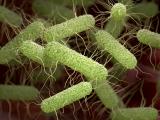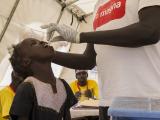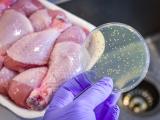Jul 9, 2008 (CIDRAP News) Federal official today advised people in high-risk categories to avoid eating raw jalapeno and Serrano peppers in light of new clues that suggest they might be associated with a nationwide Salmonella outbreak linked to tomatoes that has so far sickened 1,017 people.
Robert Tauxe, MD, MPH, deputy director of the Center for Disease Control and Prevention's (CDC's) Division of Foodborne, Bacterial and Mycotic Diseases, told reporters at a press conference today that the high-risk group includes people who have impaired immune systems, infants, and elderly people. However, he said others who want to avoid Salmonella risks can take similar precautions.
The agency defended its decision to apply the warning to a narrower high-risk group. Tauxe said federal officials also issued a more limited advisory during the early stages of the outbreak when tomatoes were the primary suspect.
Officials said tomatoes are still strongly associated with the outbreak, but a second round of case control studies focusing on patients who got sick later on in the outbreakin June rather than Maypoints more toward jalapeno and Serrano peppers, two types of hot peppers that are commonly included in Mexican and southwestern recipes. The second case-control study consisted of more than 400 people, including 144 who became ill after Jun 1.
Some of best new information implicating peppers has come from recently identified case clusters, explained Tauxe. Though many states have recently reported smaller clusters, he said the CDC is intensifying its investigation of three large ones. In one of the large clusters, illnesses were linked to both fresh tomatoes and jalapenos. However, the other two clusters were connected to an item that contained fresh jalapenos but none of the other suspected produce items, which also includes fresh cilantro.
"Neither tomatoes or jalapenos explain the entire outbreak," Tauxe said. The warnings don't apply to commercial salsas, he added.
The outbreak involves the relatively rare Salmonella enterica serotype Saintpaul. In early June the FDA warned consumers not to eat raw red plum, red Roma, or red round tomatoes, or products that contain any of those varieties, unless the growing areas are on a list posted on the agency's Web site. Officials said today they have not withdrawn the advisory about tomatoes.
Steve Sundlof, director of the Center for Food Safety and Applied Nutrition at the Food and Drug Administration (FDA), said the next step is to trace back the peppers from the restaurants connected with the case clusters. He said the FDA will also trace the products forward to see where else they went. He added that states are conducting some lab tests on peppers.
David Acheson, MD, the FDA's associate commissioner for foods, said officials don't know yet if the suspected peppers are from domestic or imported sources. He said investigators aren't out sampling on pepper farms yet because they are gathering evidence from the distribution chain. Investigators will be exploring the possibility that tomatoes and jalapenos had some type of crossover exposure to Salmonella, such as at a farm or distribution point.
At this time the FDA does not plan to list pepper growing areas that have been cleared in the outbreak, as it did for tomatoes. "The strategy here is to aggressively pursue the trace-back of peppers and exonerate areas as quickly as possible," Acheson said.
According to the CDC's latest information, based on data from 744 patients, at least 203 people were hospitalized. The outbreak has spread to 41 states and the District of Columbia, though many of the cases occurred in Texas, New Mexico, Arizona, and Illinois. The most recent illness onset date is Jun 26, a sign that the outbreak is ongoing.
Earlier updates linked one death to the outbreak and said salmonellosis may have contributed to the death of a Texas cancer patient. Four sick people from Canada have been reported; three had recently traveled to the United States, and the fourth illness is under investigation.
Acheson acknowledged frustrations over the magnitude of the outbreak and the length of the investigation. "This is one of the most complex ones I've ever been a part of, and people continue to get sick," he said. "It's a spectacularly complex outbreak."
See also:
Jul 9 CDC Salmonella update
http://www.cdc.gov/salmonella/saintpaul
















